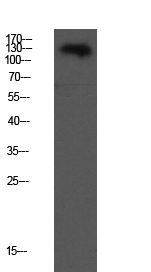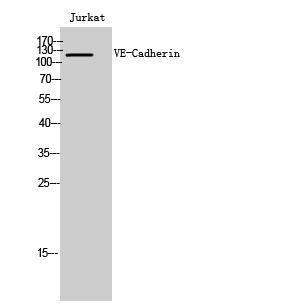VE-Cadherin (phospho Tyr731) Polyclonal Antibody
- Catalog No.:YP0808
- Applications:WB;IHC;IF;ELISA
- Reactivity:Human;Mouse
- Target:
- VE-Cadherin
- Fields:
- >>Cell adhesion molecules;>>Leukocyte transendothelial migration;>>Fluid shear stress and atherosclerosis
- Gene Name:
- CDH5
- Protein Name:
- Cadherin-5
- Human Gene Id:
- 1003
- Human Swiss Prot No:
- P33151
- Mouse Gene Id:
- 12562
- Mouse Swiss Prot No:
- P55284
- Immunogen:
- The antiserum was produced against synthesized peptide derived from human VE-Cadherin around the phosphorylation site of Tyr731. AA range:697-746
- Specificity:
- Phospho-VE-Cadherin (Y731) Polyclonal Antibody detects endogenous levels of VE-Cadherin protein only when phosphorylated at Y731.
- Formulation:
- Liquid in PBS containing 50% glycerol, 0.5% BSA and 0.02% sodium azide.
- Source:
- Polyclonal, Rabbit,IgG
- Dilution:
- WB 1:500 - 1:2000. IHC 1:100 - 1:300. ELISA: 1:20000.. IF 1:50-200
- Purification:
- The antibody was affinity-purified from rabbit antiserum by affinity-chromatography using epitope-specific immunogen.
- Concentration:
- 1 mg/ml
- Storage Stability:
- -15°C to -25°C/1 year(Do not lower than -25°C)
- Other Name:
- CDH5;Cadherin-5;7B4 antigen;Vascular endothelial cadherin;VE-cadherin;CD antigen CD144
- Observed Band(KD):
- 130kD
- Background:
- This gene encodes a classical cadherin of the cadherin superfamily. The encoded preproprotein is proteolytically processed to generate the mature glycoprotein. This calcium-dependent cell-cell adhesion molecule is comprised of five extracellular cadherin repeats, a transmembrane region and a highly conserved cytoplasmic tail. Functioning as a classical cadherin by imparting to cells the ability to adhere in a homophilic manner, this protein plays a role in endothelial adherens junction assembly and maintenance. This gene is located in a gene cluster in a region on the long arm of chromosome 16 that is involved in loss of heterozygosity events in breast and prostate cancer. [provided by RefSeq, Nov 2015],
- Function:
- function:Cadherins are calcium dependent cell adhesion proteins.,function:Cadherins are calcium dependent cell adhesion proteins. They preferentially interact with themselves in a homophilic manner in connecting cells; cadherins may thus contribute to the sorting of heterogeneous cell types. This cadherin may play a important role in endothelial cell biology through control of the cohesion and organization of the intercellular junctions. It associates with alpha-catenin forming a link to the cytoskeleton.,similarity:Contains 5 cadherin domains.,subcellular location:Found at cell-cell boundaries and probably at cell-matrix boundaries.,tissue specificity:Endothelial tissues and brain.,
- Subcellular Location:
- Cell junction . Cell membrane ; Single-pass type I membrane protein . Found at cell-cell boundaries and probably at cell-matrix boundaries. KRIT1 and CDH5 reciprocally regulate their localization to endothelial cell-cell junctions. .
- Expression:
- Endothelial tissues and brain.
Tumor necrosis factor ligand-related molecule 1A maintains blood–retinal barrier via modulating SHP-1-Src-VE-cadherin signaling in diabetic retinopathy. FASEB JOURNAL Faseb J. 2021 Nov;35(11):e22008 WB Rat,Human 1:1000 HRMECs,RRMECs
- June 19-2018
- WESTERN IMMUNOBLOTTING PROTOCOL
- June 19-2018
- IMMUNOHISTOCHEMISTRY-PARAFFIN PROTOCOL
- June 19-2018
- IMMUNOFLUORESCENCE PROTOCOL
- September 08-2020
- FLOW-CYTOMEYRT-PROTOCOL
- May 20-2022
- Cell-Based ELISA│解您多样本WB检测之困扰
- July 13-2018
- CELL-BASED-ELISA-PROTOCOL-FOR-ACETYL-PROTEIN
- July 13-2018
- CELL-BASED-ELISA-PROTOCOL-FOR-PHOSPHO-PROTEIN
- July 13-2018
- Antibody-FAQs
- Products Images

- Enzyme-Linked Immunosorbent Assay (Phospho-ELISA) for Immunogen Phosphopeptide (Phospho-left) and Non-Phosphopeptide (Phospho-right), using VE-Cadherin (Phospho-Tyr731) Antibody

- Immunohistochemistry analysis of paraffin-embedded human brain, using VE-Cadherin (Phospho-Tyr731) Antibody. The picture on the right is blocked with the phospho peptide.

- Western blot analysis of lysates from HepG2 cells treated with Na3VO4 0.3mM 40', using VE-Cadherin (Phospho-Tyr731) Antibody. The lane on the right is blocked with the phospho peptide.


